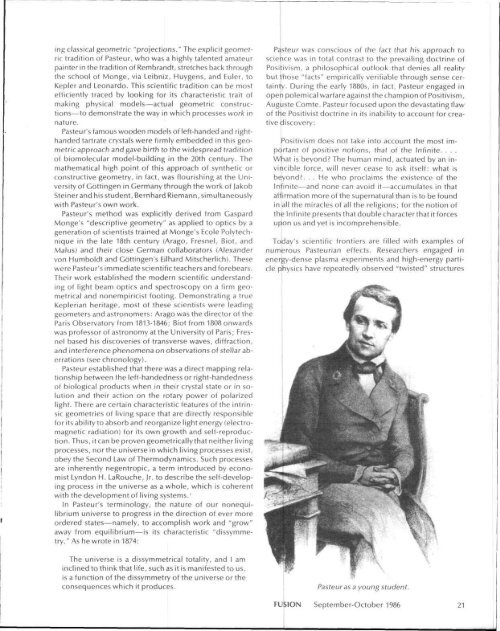Create successful ePaper yourself
Turn your PDF publications into a flip-book with our unique Google optimized e-Paper software.
ing classical geometric "projections." <strong>The</strong> explicit geometric<br />
tradition <strong>of</strong> <strong>Pasteur</strong>, who was a highly talented amateur<br />
painter in the tradition <strong>of</strong> Rembrandt, stretches back through<br />
the school <strong>of</strong> Monge, via Leibniz, Huygens, and Euler, to<br />
Kepler and Leonardo. This scientific tradition can be most<br />
efficiently traced by looking for its characteristic trait <strong>of</strong><br />
making physical models—actual geometric constructions—to<br />
demonstrate the way in which processes work in<br />
nature.<br />
<strong>Pasteur</strong>'s famous wooden models <strong>of</strong> left-handed and righthanded<br />
tartrate crystals were firmly embedded in this geometric<br />
approach and gave birth to the widespread tradition<br />
<strong>of</strong> biomolecular model-building in the 20th century. <strong>The</strong><br />
mathematical high point <strong>of</strong> this approach <strong>of</strong> synthetic or<br />
constructive geometry, in fact, was flourishing at the University<br />
<strong>of</strong> Gottingen in Germany through the work <strong>of</strong> Jakob<br />
Steiner and his student, Bernhard Riemann, simultaneously<br />
with <strong>Pasteur</strong>'s own work.<br />
<strong>Pasteur</strong>'s method was explicitly derived from Gaspard<br />
Monge's "descriptive geometry" as applied to optics by a<br />
generation <strong>of</strong> scientists trained at Monge's Ecole Polytechnique<br />
in the late 18th century (Arago, Fresnel, Biot, and<br />
Malus) and their close German collaborators (Alexander<br />
von Humboldt and Gottingen's Eilhard Mitscherlich). <strong>The</strong>se<br />
were <strong>Pasteur</strong>'s immediate scientific teachers and forebears.<br />
<strong>The</strong>ir work established the modern scientific understanding<br />
<strong>of</strong> light beam optics and spectroscopy on a firm geometrical<br />
and nonempiricist footing. Demonstrating a true<br />
Keplerian heritage, most <strong>of</strong> these scientists were leading<br />
geometers and astronomers: Arago was the director <strong>of</strong> the<br />
Paris Observatory from 1813-1846; Biot from 1808 onwards<br />
was pr<strong>of</strong>essor <strong>of</strong> astronomy at the University <strong>of</strong> Paris; Fresnel<br />
based his discoveries <strong>of</strong> transverse waves, diffraction,<br />
and interference phenomena on observations <strong>of</strong> stellar aberrations<br />
(see chronology).<br />
<strong>Pasteur</strong> established that there was a direct mapping relationship<br />
between the left-handedness or right-handedness<br />
<strong>of</strong> biological products when in their crystal state or in solution<br />
and their action on the rotary power <strong>of</strong> polarized<br />
light. <strong>The</strong>re are certain characteristic features <strong>of</strong> the intrinsic<br />
geometries <strong>of</strong> living space that are directly responsible<br />
for its ability to absorb and reorganize light energy (electromagnetic<br />
radiation) for its own growth and self-reproduction.<br />
Thus, it can be proven geometrically that neither living<br />
processes, nor the universe in which living processes exist,<br />
obey the Second Law <strong>of</strong> <strong>The</strong>rmodynamics. Such processes<br />
are inherently negentropic, a term introduced by economist<br />
Lyndon H. LaRouche, Jr. to describe the self-developing<br />
process in the universe as a whole, which is coherent<br />
with the development <strong>of</strong> living systems.'<br />
In <strong>Pasteur</strong>'s terminology, the nature <strong>of</strong> our nonequilibrium<br />
universe to progress in the direction <strong>of</strong> ever more<br />
ordered states—namely, to accomplish work and "grow"<br />
away from equilibrium—is its characteristic "dissymmetry."<br />
As he wrote in 1874:<br />
<strong>The</strong> universe is a dissymmetrical totality, and I am<br />
inclined to think that life, such as it is manifested to us,<br />
is a function <strong>of</strong> the dissymmetry <strong>of</strong> the universe or the<br />
consequences which it produces.<br />
<strong>Pasteur</strong> was conscious <strong>of</strong> the fact that his approach to<br />
science was in total contrast to the prevailing doctrine <strong>of</strong><br />
Positivism, a philosophical outlook that denies all reality<br />
but those "facts" empirically verifiable through sense certainty.<br />
During the early 1880s, in fact, <strong>Pasteur</strong> engaged in<br />
open polemical warfare against the champion <strong>of</strong> Positivism,<br />
Auguste Comte. <strong>Pasteur</strong> focused upon the devastating flaw<br />
<strong>of</strong> the Positivist doctrine in its inability to account for creative<br />
discovery:<br />
Positivism does not take into account the most important<br />
<strong>of</strong> positive notions, that <strong>of</strong> the Infinite. . . .<br />
What is beyond? <strong>The</strong> human mind, actuated by an invincible<br />
force, will never cease to ask itself: what is<br />
beyond?. . . He who proclaims the existence <strong>of</strong> the<br />
Infinite—and none can avoid it—accumulates in that<br />
affirmation more <strong>of</strong> the supernatural than is to be found<br />
in all the miracles <strong>of</strong> all the religions; for the notion <strong>of</strong><br />
the Infinite presents that double character that it forces<br />
upon us and yet is incomprehensible.<br />
Today's scientific frontiers are filled with examples <strong>of</strong><br />
numerous <strong>Pasteur</strong>ian effects. Researchers engaged in<br />
energy-dense plasma experiments and high-energy particle<br />
physics have repeatedly observed "twisted" structures<br />
<strong>Pasteur</strong> as a young student.<br />
FUSION September-October 1986 21

















